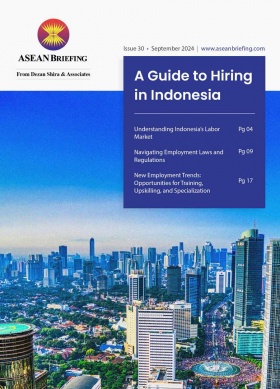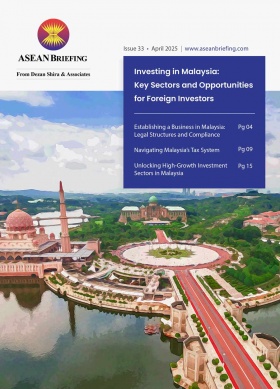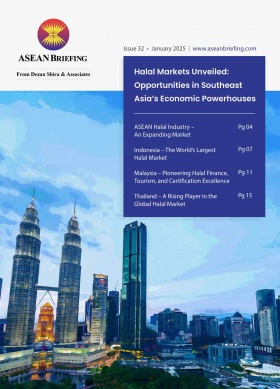How U.S. Tariff Exemptions on Electronics Could Reshape Southeast Asia’s Manufacturing Landscape
The United States’ decision to exempt a wide range of electronics products from new 2025 tariffs marks a critical turning point for global trade and supply chains. As American companies seek to reduce reliance on China, Southeast Asia has emerged as a natural partner—offering both competitive production capabilities and deepening integration into global electronics networks.
In 2024, U.S. goods imports from ASEAN totaled approximately US$352.3 billion. Electronics accounted for nearly 20 percent of those imports, doubling from 10 percent in 2017. The electronics segment has been one of the primary drivers of the 13.3 percent year-on-year increase in trade, signaling growing interdependence between Southeast Asia’s manufacturing ecosystem and the U.S. technology sector.
What the U.S. tariff exemption covers
The U.S. finalized exemptions for approximately US$100 billion in electronics imports, covering semiconductors, printed circuit boards, laptops, smartphones, and key components used in computing and telecom equipment. This move benefits global tech firms like Apple, HP, Dell, and others that rely heavily on Southeast Asian supply chains.
For ASEAN manufacturers, the tariff relief provides a boost to a sector already growing rapidly across the region. With rising investments in semiconductor fabs, chip testing plants, and R&D centers, ASEAN is positioning itself for long-term competitiveness in global supply chains.
Mapping ASEAN’s manufacturing strengths
Each ASEAN country offers unique advantages in the electronics value chain—from component manufacturing to assembly and innovation.
Vietnam: A high-growth electronics export powerhouse
Among the region’s standouts is Vietnam, which has transformed into one of the world’s fastest-growing electronics manufacturing hubs. In 2024, it exported approximately US$149.6 billion in electronics to the U.S., up from just a fraction of that a decade ago. The country has attracted top-tier manufacturers such as Samsung, LG, Intel, Canon, Foxconn, Siemens, and Panasonic, driven by competitive costs, industrial parks, and free trade zone efficiency.
Case Study – Foxconn in Vietnam
In early 2024, Foxconn announced the construction of a new US$200 million electronics assembly plant in Bac Giang Province. The facility is expected to support Apple’s global supply chain and employ over 5,000 workers. It is part of Foxconn’s broader expansion across northern Vietnam, targeting the production of iPads and MacBooks.
Malaysia: Semiconductor engine of Southeast Asia
Neighboring Vietnam, Malaysia continues to hold its position as a semiconductor stronghold, especially in back-end processes like assembly, testing, and packaging. In 2024, electronics and electrical products made up 39.9 percent of total exports, underlining the sector’s dominance.
It continues to attract major U.S. companies such as Intel, Micron, and Texas Instruments, with infrastructure and government incentives enhancing its role in global value chains. Malaysia secured US$41.7 billion in total investment in 2022, much of it concentrated in the semiconductor sector.
Case Study – Intel’s US$7 billion expansion
Intel’s new advanced packaging facility in Penang, announced in 2022, is one of the largest in the region. Slated to begin operations in 2025, it supports Intel’s Foundry Services initiative and strengthens Malaysia’s foothold in high-value chip production. The facility is expected to create over 4,000 jobs and position Malaysia as a key player in advanced packaging technologies.
Singapore: High-end electronics, semiconductors, and HQ hub
Beyond large-scale manufacturing, Singapore plays an indispensable role in the region through advanced manufacturing, R&D, and regional coordination. In 2023, its semiconductor output was valued at SGD 133 billion, contributing 9.7 percent to the GDP. The country also hosts regional headquarters for Google, Amazon Web Services, IBM, and Meta, reflecting its reputation for operational excellence and legal certainty.
The government’s commitment is clear: SGD 1 billion has been earmarked for semiconductor R&D through 2025, part of a larger SGD 28 billion five-year R&D strategy to ensure the country remains globally competitive in future technologies.
Indonesia: An emerging player with national-scale ambitions
Rounding out the region’s top contenders, Indonesia is rapidly scaling its manufacturing capabilities. As of Q3 2024, its electronics exports reached US$10.07 billion, growing at 7.29 percent year-on-year. Electronics clusters in Batam and West Java have become hot spots for investment.
Under the Omnibus Law, Indonesia offers tax holidays, simplified licensing, and local content incentives (TKDN). Global giants LG, Panasonic, and Foxconn have made major moves in the country, with Batam fast becoming a regional assembly base for consumer electronics.
Thailand: Regional leader in HDDs and automotive electronics
Thailand brings a different advantage to the table. It has long been a regional hub for hard disk drives (HDDs), automotive electronics, and robotics. Global manufacturers, including Western Digital and Seagate, have operated in Thailand for decades, benefiting from logistical access to key ports and strong engineering programs.
The Eastern Economic Corridor (EEC) continues to attract electronics investments with tax holidays, streamlined customs, and smart city infrastructure. Thailand’s Industry 4.0 vision supports the shift toward automation and advanced electronics.
The Philippines: A back-end semiconductor powerhouse
Completing the regional picture is the Philippines, a vital node in back-end semiconductor production, particularly in testing and assembly. Semiconductors account for 50 percent of the country’s exports, and many U.S. clients rely on its PEZA zones for reliable, cost-effective operations.
Skilled labor, English fluency, and proximity to Taiwan and Japan make the Philippines attractive for multinationals looking to consolidate chip assembly operations.
Labor costs and workforce capabilities across ASEAN
Labor cost competitiveness and skill levels play a significant role in determining where different stages of electronics production are located.
- Vietnam: Low wages (US$280–320/month), high assembly-line efficiency
- Malaysia: Moderate costs (~US$450–500/month), skilled technicians
- Indonesia: Competitive wages (US$250–300/month), large but less specialized labor pool
- Thailand: Skilled in automotive electronics (~US$400–450/month)
- Philippines: Cost-effective, English-speaking labor for back-end operations
- Singapore: High-cost (over US$2,000/month), ideal for R&D and HQ roles
This multi-tiered structure allows investors to optimize supply chains across the region based on cost, talent, and production complexity.
Structural constraints and talent gaps
While ASEAN’s electronics manufacturing sector is gaining global momentum, each country faces unique challenges in talent readiness and infrastructure development that investors must carefully consider.
Vietnam: Rapid growth meets infrastructure strain
Vietnam’s rise as an electronics export powerhouse has outpaced some aspects of its infrastructure. Although industrial parks like Bac Ninh and Binh Duong offer good support, congestion in ports and transportation bottlenecks continue to challenge logistics efficiency. On the talent side, Vietnam benefits from a large, young labor force with growing technical capacity—but it still faces a shortage of senior engineers and specialized electronics talent, especially in high-end semiconductor segments.
Indonesia: Balancing incentives with skills and infrastructure
Indonesia is aggressively pushing to become a regional electronics hub through policies like tax holidays and local content incentives under the Omnibus Law. The country’s talent pipeline has not fully caught up. While it offers a large labor pool with competitive wages, electronics-specific skills remain limited, especially in advanced manufacturing and testing roles. Infrastructure in zones like Batam is improving, but gaps remain in logistics connectivity and port modernization. Local content rules (TKDN) can also increase compliance complexity for foreign investors.
Malaysia: Skilled but facing talent bottlenecks
Malaysia boasts some of the most advanced electronics infrastructure in the region, especially in the semiconductor sector. Cities like Penang and Kulim are home to global leaders in back-end chip production. However, the country is beginning to experience a talent squeeze. Demand for mid-to-senior level semiconductor engineers, particularly in packaging and R&D, is outpacing supply. While technical training institutions are expanding, companies may face wage inflation and competition for top talent in the coming years.
Singapore: Highly skilled but high cost
Singapore remains the region’s hub for high-value R&D, advanced chip design, and regional coordination. Its universities and talent development programs have produced a world-class electronics workforce.
This talent comes at a premium. High wages and operating costs can be prohibitive for volume production, making Singapore more suitable for design, prototyping, and headquarter functions. Still, its stability, ease of doing business, and strong IP protection make it a critical node in the regional electronics value chain.
Thailand: Well-trained but sector-specific
Thailand’s strength lies in automotive electronics and robotics supported by established engineering programs and deep manufacturing experience. However, its talent ecosystem is relatively sector-specific. Skills in general-purpose consumer electronics or semiconductors are less developed than in Malaysia or Vietnam. Infrastructure in the Eastern Economic Corridor (EEC) is a bright spot—offering world-class connectivity and smart city planning—but workforce upskilling remains a key priority.
The Philippines: Strong back-end capabilities with gaps in R&D
The Philippines is known for its role in back-end semiconductor processes supported by a cost-effective, English-speaking workforce. However, most electronics roles are concentrated in assembly and testing, with limited capacity in front-end design or semiconductor R&D. Infrastructure within PEZA zones is reliable, but broader logistics and inter-island transportation systems can be inconsistent. The government is pushing for digital transformation and upskilling, but investors should be aware of these capability gaps.
Future U.S. tech tariffs: A reprieve amid looming levies
While the 2025 tariff exemptions provide immediate relief for electronics exporters, the U.S. administration has indicated that these exemptions are temporary. Smartphones, laptops, and other consumer electronics currently excluded will soon face separate, sector-specific scrutiny under a national security investigation into semiconductors, conducted under Section 232 of the Trade Expansion Act.
The investigation, announced by Commerce Secretary Gina Raimondo, aims to determine whether reliance on certain semiconductor imports poses a threat to national security. This could lead to future targeted tariffs or restrictions, particularly on strategic technologies.
For Southeast Asian manufacturers, this underscores the need for long-term resilience planning. The U.S. trade stance on tech is increasingly tied to national security concerns, and companies in ASEAN will need to remain adaptable to shifting U.S. policies.
ASEAN’s electronics future: Scaling toward US$3 Trillion
According to industry forecasts, ASEAN’s share of global electronics exports is expected to grow nearly 90 percent, surpassing US$3 trillion by 2031—a pace almost three times faster than the worldwide average. This surge reflects a broader structural evolution in the region’s industrial landscape, driven by increased foreign direct investment, national strategies focused on electronics development, and deepening integration into global supply chains.
Rather than serving only as low-cost assembly hubs, ASEAN countries are climbing the value chain—investing in semiconductor facilities, chip testing plants, and R&D centers. From mass production in Vietnam and Malaysia to advanced innovation in Singapore, the region is poised to emerge as one of the most competitive and strategic electronics manufacturing blocs globally.
About Us
ASEAN Briefing is one of five regional publications under the Asia Briefing brand. It is supported by Dezan Shira & Associates, a pan-Asia, multi-disciplinary professional services firm that assists foreign investors throughout Asia, including through offices in Jakarta, Indonesia; Singapore; Hanoi, Ho Chi Minh City, and Da Nang in Vietnam; besides our practices in China, Hong Kong SAR, India, Italy, Germany, and USA. We also have partner firms in Malaysia, Bangladesh, the Philippines, Thailand, and Australia.
Please contact us at asean@dezshira.com or visit our website at www.dezshira.com and for a complimentary subscription to ASEAN Briefing’s content products, please click here.








